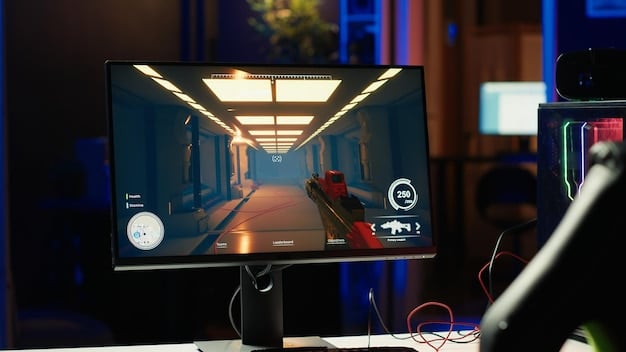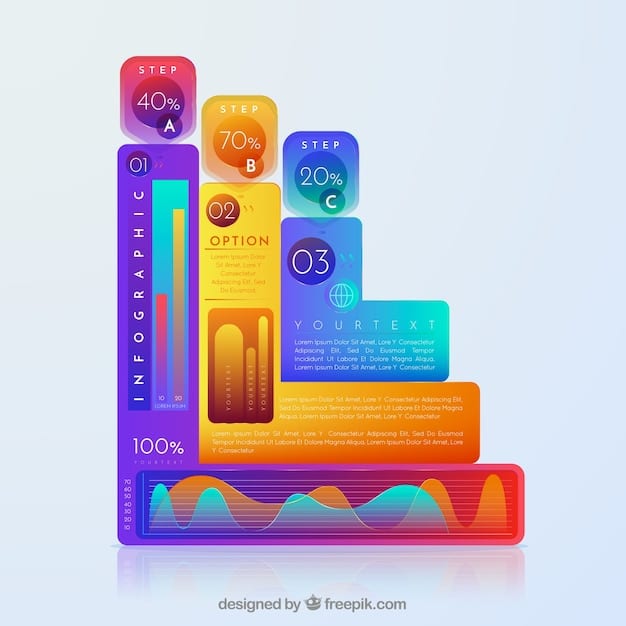8GB vs 16GB Graphics Cards in 2025: Real-World Performance

In 2025, the real-world performance difference between 8GB and 16GB graphics cards will largely depend on the game resolution, graphical settings, and specific title, with 16GB cards offering a smoother experience at higher settings and resolutions, especially in demanding games.
Will upgrading to a 16GB graphics card make a noticeable difference in your gaming experience by 2025? The answer isn’t as straightforward as you might think. Let’s delve into the real-world performance difference between 8GB and 16GB graphics cards in 2025 and see what the future holds for gamers. In this review, we seek to discover what’s the real-world performance difference between 8GB and 16GB graphics cards in 2025?
The Evolving Landscape of PC Gaming in 2025
The PC gaming landscape is constantly evolving, with new technologies and demanding game releases pushing the boundaries of hardware requirements. Understanding these trends is crucial to assess the longevity and relevance of your graphics card.
The Rise of High-Resolution Gaming
More gamers are embracing higher resolutions like 1440p and 4K, which place a significant strain on graphics card memory. Textures and frame buffer data consume more memory at higher resolutions, potentially leading to performance bottlenecks with 8GB cards.
Increasingly Complex Game Worlds
Modern game developers are creating increasingly complex and detailed game worlds with high-resolution textures, advanced lighting effects, and intricate geometry. These features require significant memory bandwidth and capacity for smooth performance.
- 📈 Higher resolutions demand more VRAM for textures and frame buffers.
- 🎮 Complex game worlds with detailed environments need more memory.
- ⚙️ Advanced graphical features like ray tracing significantly increase memory usage.
The trends toward higher resolutions and more complex game worlds suggest that 16GB graphics cards will become increasingly necessary for a smooth gaming experience in 2025, especially for gamers who want to enjoy the latest titles at their maximum graphical settings.

How VRAM Capacity Affects Performance
VRAM, or video RAM, is the dedicated memory on your graphics card that stores textures, frame buffers, and other graphical data. Insufficient VRAM can lead to noticeable performance issues, especially in demanding games.
Stuttering and Frame Rate Drops
When a graphics card runs out of VRAM, it starts swapping data between the VRAM and system RAM. This process is much slower, leading to noticeable stuttering and frame rate drops in the game.
Texture Pop-In
Insufficient VRAM can also cause texture pop-in, where high-resolution textures take a noticeable amount of time to load, resulting in a distracting visual artifact.
The amount of VRAM available on a graphics card directly impacts its ability to handle demanding games at high resolutions and graphical settings. Insufficient VRAM leads to performance issues and visual artifacts, diminishing the gaming experience.
Benchmarking 8GB vs 16GB Cards in 2025
To accurately assess the performance difference of 8GB and 16GB graphics cards in 2025, it’s important to consider both synthetic benchmarks and real-world game testing.
Synthetic Benchmarks
Synthetic benchmarks like 3DMark and Unigine Heaven provide a standardized way to measure the performance of graphics cards under controlled conditions. These benchmarks can highlight the theoretical performance differences between 8GB and 16GB cards.
Real-World Game Testing
Real-world game testing involves running popular and demanding games on both 8GB and 16GB graphics cards and comparing the frame rates and visual quality achieved. This provides a more realistic assessment of the performance difference in actual gaming scenarios.

Games That Will Benefit From 16GB VRAM in 2025
Certain games are more demanding on VRAM than others, making them excellent test cases for evaluating the benefits of 16GB graphics cards. These games often feature large open worlds, high-resolution textures, and advanced graphical effects.
Open-World Games
Games with large, open-world environments like Cyberpunk 2077, Assassin’s Creed Valhalla, and Red Dead Redemption 2 often require significant VRAM to store the textures and geometry of the vast game world.
Ray Tracing Enabled Titles
Ray tracing is a computationally intensive rendering technique that simulates the physical behavior of light. Games that implement ray tracing, such as Control, Metro Exodus, and Dying Light 2, can significantly benefit from the additional VRAM provided by 16GB cards.
- 🌆 Open-world games like Cyberpunk 2077 and Red Dead Redemption 2.
- 🔦 Ray tracing enabled titles like Control and Metro Exodus.
- 🚀 Games with high-resolution textures such as Forza Horizon 5.
Gamers who enjoy playing these types of games at high resolutions and graphical settings will likely see a noticeable performance improvement by upgrading to a 16GB graphics card in 2025.
The Cost Factor: Is 16GB Worth the Investment?
The price difference between 8GB and 16GB graphics cards can be significant. It is essential to weigh the potential performance benefits against the additional cost before making a decision.
Assessing Your Gaming Needs
If you primarily play less graphically demanding games at 1080p resolution, an 8GB graphics card may still be sufficient in 2025. However, if you plan on gaming at higher resolutions or playing the latest AAA titles, a 16GB card is likely a worthwhile investment.
Future-Proofing Your PC
Investing in a 16GB graphics card can help future-proof your PC, ensuring that it remains capable of handling demanding games for longer. This can save you money in the long run by delaying the need for another upgrade.
Making the Right Choice for Your Gaming Rig
Choosing between an 8GB and 16GB graphics card in 2025 depends on your budget, gaming habits, and desired level of performance. Understanding the performance implications of VRAM capacity is crucial in making an informed decision.
Consider Your Budget
Determine how much you are willing to spend on a graphics card and weigh the cost against the potential performance benefits of a 16GB card.
Evaluate Your Gaming Habits
Consider the types of games you play most often and the resolutions and graphical settings you prefer. If you primarily play less demanding games, an 8GB card may suffice. If you want to play the latest AAA titles at their maximum settings, a 16GB card is recommended.
The decision of whether to upgrade to a 16GB graphics card in 2025 is a personal one that depends on individual needs and priorities. By carefully considering the factors outlined above, you can make an informed choice that optimizes your gaming experience.
| Key Point | Brief Description |
|---|---|
| 🎮 VRAM Importance | VRAM is critical for textures and frame buffers, impacting performance. |
| 📈 Resolution Impact | Higher resolutions demand more VRAM, reducing performance on 8GB cards. |
| ✨ Games Suited for 16GB | Open-world and ray-tracing games benefit significantly from 16GB VRAM. |
| 💰 Cost Consideration | Balance cost with performance needs and future-proofing your PC. |
Having 16GB of VRAM allows for smoother gameplay at higher resolutions and graphical settings, especially in demanding modern games. It reduces stuttering and improves overall visual quality.
▼
Open-world games with large environments and games that utilize ray tracing technology see the biggest performance gains from 16GB of VRAM.
▼
Yes, an 8GB graphics card will still be viable for gaming in 2025, particularly for less demanding games or when playing at lower resolutions and graphical settings.
▼
Insufficient VRAM can lead to stuttering, frame rate drops, and texture pop-in, as the graphics card struggles to manage the required graphical data.
▼
The value of upgrading depends on your gaming habits, budget, and desire for future-proofing. If you want to play the latest games at high settings, it’s a worthwhile investment.
Conclusion
In conclusion, while 8GB graphics cards may still be viable for some gaming scenarios in 2025, 16GB cards will offer a more robust and future-proof solution, especially for gamers who prioritize high resolutions, maximum graphical settings, and playing the latest AAA titles.





